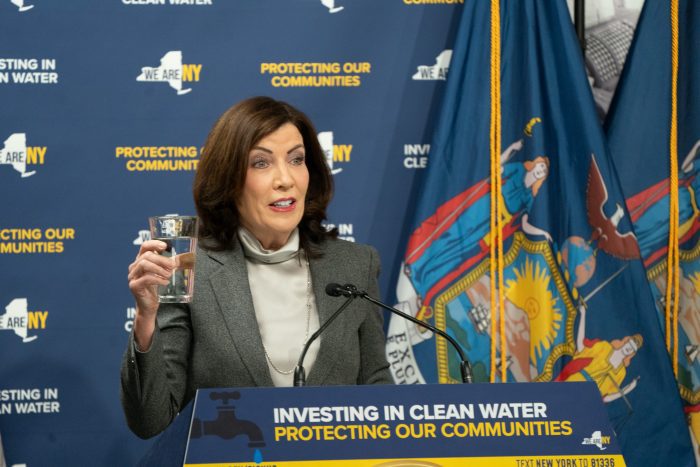Café a special addition to Emma Clark Library
If you haven’t already, set aside some time to visit the new café at our beautiful Emma S. Clark Memorial Library [Level Up Kitchen Library Café]. I took some time out this morning to have a delicious breakfast with a dear friend. There are tables and chairs set up in the sunny hallway leading to the magazine room to enjoy the delicious food. This is a wonderful addition to an already spectacular library, especially now at holiday time. A perfect spot to take a break from our hectic schedules. I can’t wait to be able to sit outside on the terrace when spring rolls around.
Madeline Morris
Setauket
Clarifying lawsuits against PJSD
An article in the Dec. 7 Port Times Record (“Suffolk school districts pay millions to settle child abuse lawsuits”) misstated that the Port Jefferson School District has settled seven lawsuits from former students. These cases, filed in Suffolk County Supreme Court in 2020 and 2021, are presently pending and have not been settled.
While the accusations made by these former students are certainly very disturbing, the behavior of the present Board of Education and the superintendent of schools needs to be closely examined by the taxpayers of this district since both were fully aware, since 2020, of these lawsuits and their possible financial implications.
Nonetheless, residents were asked on two occasions (in 2022 and 2023) to support multimillion dollar bonds as well as other questionable expenses (costly new bleachers and a ”security booth” at the high school, etc.), thereby depleting capital reserves, while a large legal cloud loomed overhead and was unknown to taxpayers.
The board and superintendent, understandably, could not disclose the specific details of the seven lawsuits. However, in the interest of both transparency as well as the responsibility to be diligent guardians of district funds, some indication of the possible financial implication of this situation should have been made known to taxpayers prior to costly undertakings since, ultimately, these taxpayers would have to pick up the tab. Instead, the superintendent and the board majority continued their ”heads in the sand” approach, with excessive spending despite declining student enrollment, dwindling LIPA revenue and seven pending lawsuits.
In their expose of child abuse lawsuits and settlements on Long Island, Newsday interviewed Ron Masera, of the Suffolk County School Superintendents Association, who stated (in a video interview posted on Newsday’s website), “This is the age of transparency. We’re in a place where this is not something you can or should hide from your community.”
By this standard of transparency, the Port Jefferson superintendent and the Board of Education deserve an “F.”
Charles G. Backfish
Port Jefferson
Thank you, voters
To the residents of the 12th Legislative District, both former and new.
Thank you for returning me to my fifth full term as your Suffolk County legislator. I am truly humbled and honored by the overwhelming measure of support you have provided. Having been reelected, the challenge now becomes how to govern wisely, fairly and equitably with our newly elected county executive [Ed Romaine (R)].
I look forward to continuing my efforts to preserve our suburban way of life, to keep an eye on affordability and to deliver services to our veterans and seniors and families as their needs continue to increase.
As many of you became aware, the lines of the 12th Legislative District shifted east from the Commack area, my hometown, all the way to the Centereach/Selden/Holbrook borders. I will miss my past constituents but look forward to the new opportunities and community issues to address in the upcoming legislative term.
Please feel free to contact me at my office at 631-854-3735, or at [email protected] with any questions or concerns.
I wish a Merry Christmas, Happy Hanukkah, a joyous Kwanzaa and Happy Holidays to all. Remember those in need, and check on a neighbor.
With thanks and great regard,
Leslie Kennedy (R-Nesconset)
Suffolk County Legislator
12th District
Community vision for Jefferson Plaza
I was extremely proud of how the Port Jefferson Station/Terryville community turned out to voice their opinions at the Brookhaven Town Board meeting on Thursday, Nov. 30. It was an honor to represent the hamlet in a worthwhile discussion regarding the amount of multifamily rental units, building heights, architectural design and traffic issues along Route 112 and Terryville Road.
We are fortunate to have Councilmember Jonathan Kornreich [D] and Supervisor-elect Dan Panico [R] guiding us through the Staller redevelopment process of the Jefferson Shopping Plaza. Political leaders often do not get credit for the time and devotion they give to the constituents they represent. The Port Jefferson Station/Terryville community should be encouraged by the steady hand displayed on that long Thursday night by our elected officials who will make sure the project will be something exciting and something of which the residents will be proud.
By working with Staller Associates, our local civic association and the chamber of commerce, I have the utmost confidence the supervisor-elect and our councilmember will put in the hard work to bring quality revitalization all along the Route 112 corridor.
Carolyn Sagliocca, Vice President
Port Jefferson Station/Terryville Civic Association
Concerning incident at Village Hall
At a recent Village board meeting, I found myself at the center of a concerning situation that raises questions about the responsible use of village resources, particularly regarding the village attorney, whose fees are paid by taxpayers.
As an engaged resident deeply invested in our community’s well-being, I’ve long upheld the principles of transparency, open communication and fairness. However, a recent incident at Village Hall has given rise to deep concerns about the potential misuse of village assets for personal and retaliatory purposes.
During a routine public board meeting, legal papers were hastily served to me as I exited, raising unsettling questions. I am concerned and disheartened, as it seems there’s an attempt to force me into surrendering control of a Facebook page, a demand that holds no merit, as I am not the page’s owner. The vindictive nature of this attempt to seize control of a Facebook page, raises significant doubts about the real motivations behind such actions and whether they align with the values we, as a community, hold dear.
The involvement of the village attorney in this matter is particularly distressing. The village attorney’s role is to serve the community’s best interests, not to be manipulated for personal vendettas. Using taxpayer-funded legal resources for what appears to be a personal matter is both ethically questionable and an inappropriate use of public funds. When I directly questioned the attorney if he was acting in his capacity as the village attorney, he stated that he was “acting at the direction of the mayor.”
How can we believe the mayor’s recent proposals for a new ethics code and professing transparency while this incident clearly lacks both. It’s disheartening when actions contradict the very principles being advocated.
Moreover, it’s crucial to note that this action was taken at the mayor’s direction without the knowledge of the trustees, further clouding the transparency and accountability of village affairs.
As a concerned resident, I question the motives behind this action and the appropriateness of utilizing village resources for such questionable purposes. I hope this incident sparks a much-needed dialogue within our community about the responsible use of public funds and the imperative of fostering an environment where disputes can be resolved through open communication rather than by weaponizing the village attorney.
Let’s collaborate to ensure our village resources are used judiciously and that our community stands as a shining example of fairness, true transparency and cooperation for all residents.
Kathianne Snaden
Port Jefferson
Editor’s note: The writer served as Port Jeff Village trustee from 2019-23.
The perils of bail reform
I would like to respond to Timothy Glynn’s letter of Nov. 23 regarding bail reform [“Why cashless bail is right”]. I take exception to his statement that “New York’s vision of bail reform was limited to misdemeanors and nonviolent felonies’” and we should “take the dangerous criminal argument off the table.” He probably did not hear about the Quogue woman accused of trying to burn multiple houses in Hampton Bays as reported by News 12 on Nov. 14.
She was arrested and released without bail and less than two hours later tried to rob a Dollar store armed with a knife. I would hope Mr. Glynn would reconsider his position about what he considers a dangerous criminal. This incident was not a person arrested for shoplifting a loaf of bread. This was a person accused of three felony arson charges. I hope reasonable people can agree that is most certainly a dangerous criminal act. The “bail reform” law has been “tweaked” by lawmakers a couple of times already and still there are serious problems with it. It could be because the law was passed by one party with no stakeholder input from law enforcement or district attorneys. Passing a law with such serious implications to the safety and security of the entire state based on ideology alone is not proving to be a wise or successful endeavor. I have never seen data suggesting that a liberal state like New York had large numbers of petty criminals languishing in our jails. The one anecdote used by the more extreme proponents of bail reform cites a case about a person they say went to jail for merely stealing a backpack. Researching that case reveals misinformation. The person involved was charged with robbery, not larceny, and was held due to being on probation at the time of his arrest.
I think the solution is having a “dangerousness standard” like the other 49 states have, so a judge can ensure that dangerous criminals are held. I think reasonable people can agree to release petty criminals, but can we also agree that a shoplifter with 50 or 80 arrests is showing they don’t care about following the law. If not, we could end up like Washington, D.C., where you have to ring a bell in the store to buy a roll of toilet paper since it’s locked up to prevent theft.
Common sense should prevail.
Charles Tramontana
Setauket














































